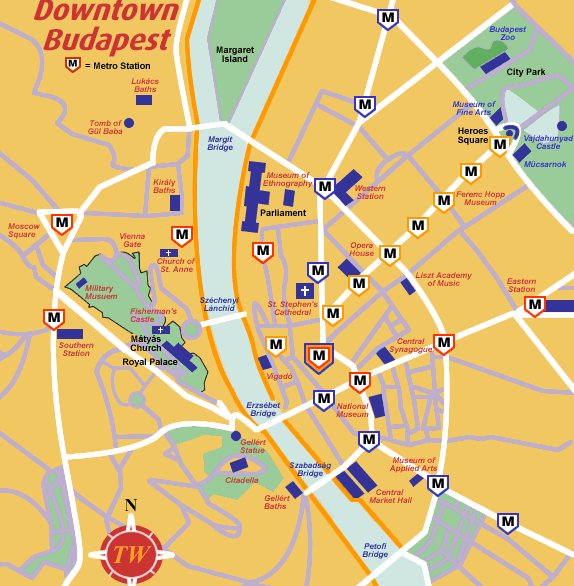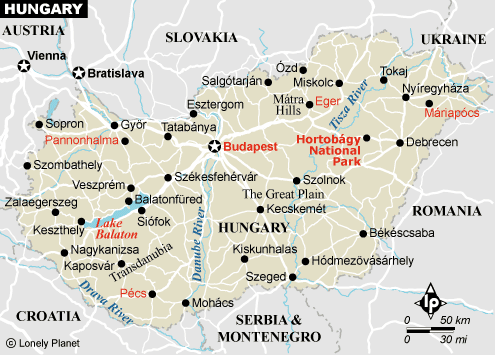Travels by Bus
See the world on bus, ON foot & on my own.
HUNGARY
May 2004
BUDAPEST, SIÓFOK/LAKE BALATON, GYÖR
07
days
PEST OF BUDA
Budapest, the capital of Hungary, is situated along the Danube.
The hilly Buda is on the western side, while the flat Pest on the east is where most attractions are located and it was here that I found a bed at the Kinzinski Hostel near the Petrofi Bridge.



Looking at the map here, you can see that the city is very well linked with the underground Metro. There were 4 lines, each with a different colour so it's really easy to travel around. A single ticket cost only 145FT (60 Euro cents).
Walking around, I like the turn-of-the-last-century architecture although quite a number needed reworks. This building on the left reminded me of public housing back home.
Walking around, I like the turn-of-the-last-century architecture although quite a number needed reworks. This building on the left reminded me of public housing back home.
The most outstanding, I agree, was Andrássy Avenue which was bordered by mansions carefully designed and erected in the 1870’s.
The poshest of Budapest, there are the likes of Gucci shops to be found here. It was here that I came across the statue of Jokai and Liszt Franz.







Quite logically, you find the Academy of Music and The Opera designed and built by Miklós Ybl in 1884 here, while Ödön Lechner was the architect of the Museum of Applied Arts.
Goethe Institute is also located here.
Underneath Andrassy Street ran the oldest underground in the Continent: the tracks so narrow, it was barely passable to trains.

Since Budapest spas is the most popular in Europe, I went to see the Szechenyi spa. Unfortunately, it was raining so I didn't go in. I liked the Gellért Hotel Spa but it was very crowded so I didn't get to go in either.
When Tamas came to Budapest to show me around, he took me to the Synagogue.




Next was St Sebastian Church designed by Jozsef Hild in 1845. It was so huge, it holds more than 8000 worshipper.! When we saw the stage outside, I'd like to be here when a concert is on...
We continued on to The Parliament building, Lánchíd and Roosevelt Square.
Originally built between 1842-1849, the Lánchid was the first permanent span across the Danube between Buda and Pest.
Designed by English engineer, Adam Clark, the bridge's first use was to allow the Hungarian Army of Independence to retreat from the advancing Austrians in 1849. The Austrians then tried to blow up the bridge with explosives, but luckily the charges failed to detonate.






A shot of the Parliament and Museum of Ethnography is best taken across the river with a zoom.
Far out on the eastern side of Pest is the Kinai Piac where you can buy any kind of clothing from Chinese stalls. I was amused to see families crowding around a small TV watching video tape of old Chinese drama series. Not my kind of shopping.




Kovamter (Central Market Square) is more interesting for me. Here, one can buy local produce like Hungarian salami, paprika powder, spices and fruits on the ground floor and handicraft on the second level. Váci utca is also one of my favourite (shopping) street.
BUDA OF PEST

Buda was founded in 896 but only started to develop in the 13th century when Béla IV built a castle on the hill for protection against the Mongol attacks.
Across the river Danube from Pest, I got a great view of Pest. Would have been better if it were not raining so much.
These shots were mainly taken from Fisherman's Bastion with a zoom lens but the weather is really not good.


Designed by Frigyes Schluek, the Fisherman's Bastion castle is made up of 7 round towers - each one symbolising the 7 Magyar tribes that effectively gave rise to the nation a thousand years earlier...



Its white walls and staircases looked like a Walt Disney structure to me. This area behind the church used to house a local fish market during medieval times - hence the name of the Bastion. During the 18th-century, the Guild of Fisherman are said to have defended this part of the castle wall.
From here, I walked to Matthias Church and Royal Palace.




I took a long walk downhill in the rain and finally caught the bus to Hotel Gellért spa baths. I was so tired of walking that I told myself to come back to see the Citadel another day but I never did. There is really a lot to see in Budapest!






SIÓFOK

Having enough of walking, I took a 4-hour bus to Siófok, Lake Balaton for around US$5.
Lake Balaton is one of the largest in Europe and Siófok is the largest of Balaton's resorts on the southern side of the lake. The thing to do here is eat, drink, swim & sunbath. So, if it rains, like it happened to me, you can basically forget about doing anything else!
Luckily, on the day of my arrival, it was sunny enough for these pictures to be made, sunset...



GYÖR
I went to Györ mainly to visit my Hungarian school- and classmates Tamas & Hunor. Sarah was also visiting so we all had a great time together.
Little did I know that Györ is known as the town of rivers, where the Rivers Rába and the Mosoni-Dunai (Little Danube) meet - that's the river behind us.
Györ is also a road & rail hub, a river port, a county administrative center, and a leading industrial city, known especially for its engineering works, textile plants. That's why Audi has a plant here.
It was a Roman military outpost called Arabona that was evacuated in the 4C A.D. and later destroyed. The Magyars built fortifications there in the 9C, and Györ grew around the fortress which was later (17C) used as a defensive position against the Turks.
Hunor's parents' house is right in the city centre.



There are several churches and museums around but I just went shopping only to find it very confusing when the salesgirls said "Hello" when I was leaving the shop. It always made me turn around again!
The Hungarian language is very difficult. On my visit, I only learnt "Eterem" (restaurant) and "kijarat" (exit) - because of the signs I see everyday - much to the amusement of my Hungarian friends who decided that these two words are rather essential afterall. The most amusing day, however, was when an old man stood outside the restaurant we were in who didn't stop starring at me!
The Hungarians I met in my travels often stared at me, most times in an unfriendly way. Tamas said it's due largely to the high cost of living, low pay and no holidays. Thanks to my friendly and hospitable Hungarian friends, I do not think they are all like that :-)
Soon it was time to leave. Sarah drove both of us back to Ingolstadt. It was a really nice road trip and I got to know her a lot more than I did before.